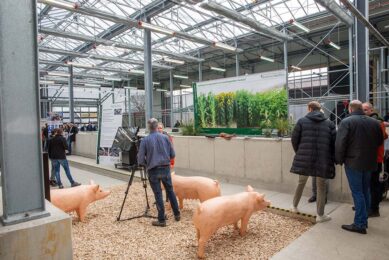Interview: Transfer of Covid-19 to pigs is unlikely

The transfer of coronavirus disease 2019 (Covid-19) to pigs and other livestock is virtually impossible, but it is good to remain vigilant. Measures will work best when they are applied widely and immediately, according to Dutch epidemiologist, Prof Arjan Stegeman.
It is very unlikely that a transfer from humans to livestock is possible in the case of SARS-Cov-2, the causative agent of the Covid-19 pandemic. Prof Arjan Stegeman is epidemiologist at the faculty of Veterinary Medicine at Utrecht University, the Netherlands.
He said, “Our farm animals have their own type of coronaviruses, but those are host specific and will not jump to a different host species. Take for instance the Porcine Epidemic Diarrhoea (PED) virus, which will spread only within pigs. Similarly, the infectious bronchitis (IB) virus in poultry will only spread within chickens. The human SARS-Cov-2 virus will have to adapt very extremely to be transferred efficiently within livestock.”
What we can learn from the animal disease approach is that the same regulations are put in place everywhere….When fighting animal diseases, it is helpful that a minimum of requirements are identical throughout the EU.”
A potential transfer of Covid-19 to livestock would be noticed in no time. Prof Stegeman said, “In epidemiological analyses there is no indication at all that contact with livestock would form a risk for infection with humans. There are no indications for sick animals due to Covid-19. In Asia, there’s plenty of attention for this, and apart from the cause of Covid-19 due to bat-human transfer, there are no known cases of transfer between humans and animals.”
Pig Progress: Virologists of the faculty of Veterinary Medicine are also involved in research to fight Covid-19. Why is that?
Prof Arjan Stegeman: “Because of the experience they have with research in coronaviruses. They have been researching coronaviruses for years, e.g. in cats, pigs, and the SARS-virus.”
What would happen in the case of an identical situation in livestock?
“That depends strongly on the disease. In that case it is a pathogen that requires action by law, the measures would be rigorous. Think the culling of infected farms and isolation zones of 10km around the infected site, which happened with Avian Influenza and Foot-and-Mouth Disease (FMD). If the case does not warrant the law telling us to combat the disease, like PED, then it is up to the industry to take action.”
What would happen if FMD would break out?
“In the case of an FMD outbreak, we would always start with a complete lockdown. Basically throughout the entire country animal transports would be banned for 72 hours. In that period, the situation would be assessed and only when the disease situation has been completely mapped, can it be lifted again. In humans one sees the opposite thing happening: the measures have started very small (no handshakes any more) and then the measures have become stricter once it turned out that they did not work. Experience has taught us in animal production to do it the other way round.”

The who’s who in the global pig production industry talk to Pig Progress…
click here for more interviews
Is it possible that the spread of a new coronavirus in livestock production could occur in a similar way as in humans?
“In livestock production we always keep animals on one site or at most they are being trucked from farm to farm or farm to slaughterhouse. In that context, measures are pretty easy to put in practice. With humans, that is not the case as humans are very mobile, going on holidays and during events like carnival a virus can spread easily.”
With animal diseases it usually helps that a minimum of requirements is applicable within the EU. What lessons can be learnt from the way animal diseases are being tackled?
“What we can learn from the animal disease approach is that the same regulations are put in place everywhere. If that wouldn’t be done, it’s easy to encourage further spread, like what has happened in Italy. Taking measures for Northern Italy only encouraged the spread to the rest of Italy. When fighting animal diseases, it is helpful that a minimum of requirements are identical throughout the EU. It doesn’t make sense to move the animals, because the identical rules will apply everywhere.”
What could veterinary medicine learn from the current Covid-19 outbreak?
“Veterinary medicine could learn from practices like hand hygiene as well as social distancing in the human Covid-19 outbreak. During an animal disease outbreak it is wise that producers of the affected animal species would mutually respect those. Often an animal disease can spread in the neighbourhood and by keeping distance as well as applying a good hygiene, it is possible to prevent spread from farm to farm.”










